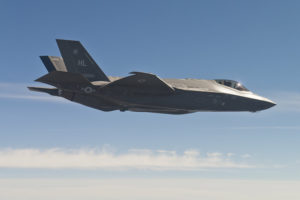
Defense authorizers in the House and Senate are directing increased oversight of the F-35 Block 4 and Continuous Capability Development and Delivery (C2D2) program.
The oversight requires the secretary of defense “to submit annually to the congressional defense committees an integrated master schedule and past performance assessment for each planned phase of Block 4 and C2D2 upgrades,” according to the House-Senate conference report on the Fiscal 2020 National Defense Authorization Act (NDAA), S. 1790.
In fiscal 2020, the bill authorizes the Pentagon budget request of nearly $695 million for C2D2 for the U.S. Air Force F-35A, $423 million for C2D2 for the U.S. Marine Corps’ F-35B, and $384 million for the U.S. Navy’s F-35C carrier variants.
“The conferees expect the secretary of defense to keep the congressional defense committees fully and promptly informed on the planning, cost, schedule, execution, fielding, and programmatic risk associated with the Block 4 and C2D2 program,” according to the report.
In the Pentagon’s fiscal 2020 budget proposal, DoD said that it plans to spend about $6.6 billion on C2D2 between 2019 and 2024, while the Government Accountability Office said last April that it used figures from the F-35 program to estimate that C2D2 will cost about $10.5 billion through 2024.
GAO said that the program office provided that Block 4 cost estimate to the DoD Cost Assessment and Program Evaluation office (CAPE) for an independent cost estimate. CAPE told GAO that it will provide the independent cost estimate before the end of the year to support an F-35 full rate production decision, yet the Pentagon recently pushed back that decision until early 2021.
“Without an independent cost estimate, Congress does not have insight into the full potential cost of the Block 4 effort,” according to GAO.
In October, the Defense Department said it finished striking a $34 billion deal with Lockheed Martin [LMT] to buy 478 F-35s and reduce the average aircraft price by 12.7 percent by Lot 14.
Under C2D2, the F-35 Joint Program Office is to develop, test, and deliver small sets of new, Block 4 capabilities for the aircraft in six-month development cycles.
Such capabilities include the integration of new weapons, such as the new version of Raytheon‘s [RTN] AIM-9X Sidewinder missile and the B61 Mod 12 nuclear bomb. In addition, there are planned software updates to improve aircraft performance and to control the new weapons, sensors, communications, and electronic warfare equipment.
Last month, Gregory Ulmer, Lockheed Martin’s vice president and general manager of the F-35 program, highlighted what he called key upgrades under C2D2, including the Automatic Ground Collision Avoidance System (AutoGCAS) to provide terrain mapping, geolocation and automation to detect and avoid potential ground collisions; manned-unmanned teaming; missile defense and extended range capabilities; Technology Refresh-3 (TR-3) upgrades to add an open system architecture to add on new capabilities quickly, such as the Next Generation Distributed Aperture System, the F-35 Integrated Core Processor, the Panoramic Cockpit Display and the Aircraft Memory System; and sensor fusion capability beginning in Lot 13 and integration of enhanced voice and data interoperability in Lot 14.
“To date, the F-35 has successfully integrated with the Aegis Missile Defense system, a High Mobility Artillery Rocket System, or HIMARS, the Integrated Air and Missile Defense Battle Command System (IBCS), and most recently in partnership with the Missile Defense Agency and U.S. Air Force, we successfully connected an F-35, U-2, and a multi-domain ground station,” Ulmer said. “The advantages of the F-35 integrated and fused sensor suite now can be made available to other airborne, air, and even subsurface warfighters.”
Advanced data links to allow the F-35 to communicate with other aircraft while maintaining stealth will also likely be a priority.
In the House-Senate report on the Fiscal 2020 NDAA, defense authorizers told the Pentagon “to develop a joint development and acquisition strategy to procure a resilient, low latency, and low probability of detection data link network capability that would enable effective operation in the contested environments highlighted in the National Defense Strategy.”
“The conferees are concerned about an absence of coordinated effort by the department and the military services on resilient, anti-jam, low probability of intercept/low probability of detection (LPI/LPD) communications,” the report said. “The conferees note that Congress previously directed a similar strategy on LPI/LPD data links in the National Defense Authorization Act for Fiscal Year 2018 (Public Law 115- 91). The department’s response was incomplete and inadequate, recommending no change to current department policy that designates the F-35’s Multifunction Advanced Data Link (MADL) as the solution for 5th to 4th generation air platform networked communications.”
“Both the Navy and Air Force acknowledge that the aircraft modifications needed to install MADL are unaffordable at scale,” according to the report. “A January, 2019 memorandum signed by all three service secretaries commits the military services to common data standards to ensure interoperability across the joint force. While this is a positive step, the conferees believe progress on the specific LPI/LPD communications issue requires additional leadership and attention from both the department and the military services. The conferees expect a more comprehensive and executable response to this legislative provision and subsequent investment in the Fiscal Year 2021 budget submission.”